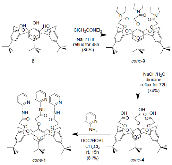|
Generalized Gradient Approximation Made Simple
|
journal
|
October 1996 |
|
Calixarenes: from biomimetic receptors to multivalent ligands for biomolecular recognition
|
journal
|
January 2010 |
|
Interlocked Macromolecules
|
journal
|
July 1999 |
|
Inclusion of [60]Fullerene in a Homooxacalix[3]arene-Based Dimeric Capsule Cross-Linked by a Pd II −Pyridine Interaction
|
journal
|
May 1999 |
|
Synthesis and Inclusion Properties ofC3-Symmetrically Capped Hexahomotrioxacalix[3]arenes with Ester Groups on the Lower Rim
|
journal
|
March 2001 |
|
A pyrene-functionalized triazole-linked hexahomotrioxacalix[3]arene as a fluorescent chemosensor for Zn2+ ions
|
journal
|
June 2016 |
|
Ab initio effective core potentials for molecular calculations. Potentials for K to Au including the outermost core orbitals
|
journal
|
January 1985 |
|
Synthesis, Complexation, and Membrane Transport Studies of 1,3-Alternate Calix[4]arene-crown-6 Conformers: A New Class of Cesium Selective Ionophores
|
journal
|
March 1995 |
|
Synthesis and evaluation of a novel pyrenyl-appended triazole-based thiacalix[4]arene as a fluorescent sensor for Ag+ ion
|
journal
|
May 2011 |
|
Alkyl Ammonium Ion Selectivity of Hexahomotrioxacalix[3]arene Triamide Derivative having the Intramolecular Hydrogen-Bonding Group
|
journal
|
November 2005 |
|
Modification of the Upper Rim of Homooxacalix[3]arenes and Complexation between a Nitrohomooxacalix[3]arene Derivative and n -Hexylamine †
|
journal
|
November 2002 |
|
Optical Chemosensor for Ag + , Fe 3+ , and Cysteine: Information Processing at Molecular Level
|
journal
|
February 2011 |
|
A Stepwise Huisgen Cycloaddition Process: Copper(I)-Catalyzed Regioselective “Ligation” of Azides and Terminal Alkynes
|
journal
|
July 2002 |
|
Recognition of 1,2-diazines by a bidentate Lewis acid
|
journal
|
January 1998 |
|
Efficient Photocurrent Generation in Novel Self-Assembled Multilayers Comprised of [60]Fullerene−Cationic Homooxacalix[3]arene Inclusion Complex and Anionic Porphyrin Polymer
|
journal
|
May 2001 |
|
Thiacalixarenes
|
journal
|
December 2006 |
|
Synthesis and ion selectivity of conformers derived from hexahomotrioxacalix[3]arene
|
journal
|
October 1993 |
|
BYPASS: an effective method for the refinement of crystal structures containing disordered solvent regions
|
journal
|
March 1990 |
|
Calixarene-Derived Fluorescent Probes
|
journal
|
September 2007 |
|
Synthesis of Mono- O -alkylated Homooxacalix[3]arene and a Protection–Deprotection Strategy for Homooxacalix[3]arene
|
journal
|
December 2016 |
|
Novel Cavity Design Using Calix[ n ]arene Skeletons: Toward Molecular Recognition and Metal Binding
|
journal
|
August 1997 |
|
Pyrene-Linked Triazole-Modified Homooxacalix[3]arene: A Unique C 3 Symmetry Ratiometric Fluorescent Chemosensor for Pb 2+
|
journal
|
February 2011 |
|
Novel Fluorometric Sensing of Ammonium Ions by Pyrene Functionalized Homotrioxacalix[3]arenes
|
journal
|
January 1994 |
|
Generalized Gradient Approximation Made Simple [Phys. Rev. Lett. 77, 3865 (1996)]
|
journal
|
February 1997 |
|
Synthesis and inclusion properties of O-tris(benzyloxy)hexahomotrioxacalix[3]arenes
|
journal
|
August 2006 |
|
A Self-Assembled Homooxacalix[3]arene-based Dimeric Capsule Constructed by a Pd II −Pyridine Interaction Which Shows a Novel Chiral Twisting Motion in Response to Guest Inclusion
|
journal
|
May 2001 |
|
Quantum Mechanical Calculations of Conformationally Relevant1H and13C NMR Chemical Shifts of N-, O-, and S-Substituted Calixarene Systems
|
journal
|
August 2007 |
|
Exploitation of Na + -Selective Electrodes for Protein Solutions from Crown-Bridged Calix[4]quinones
|
journal
|
January 1996 |
|
Click synthesis of a quinoline-functionalized hexahomotrioxacalix[3]arene: A turn-on fluorescence chemosensor for Fe3+
|
journal
|
January 2018 |
|
Ab initio effective core potentials for molecular calculations. Potentials for the transition metal atoms Sc to Hg
|
journal
|
January 1985 |
|
Synthesis and evaluation of a novel fluorescent sensor based on hexahomotrioxacalix[3]arene for Zn 2+ and Cd 2+
|
journal
|
August 2016 |
|
Artificial Organic Host Molecules for Anions
|
journal
|
August 1997 |
|
Ion and Molecular Recognition by Lower Rim 1,3-Di-conjugates of Calix[4]arene as Receptors
|
journal
|
August 2011 |
|
Synthesis, structure and inclusion properties of cone-tris{[(5′-methyl-2,2′-bipyridyl)-5-yl]oxycarbonylmethoxy}hexahomotrioxacalix[3]arene
|
journal
|
March 2011 |
|
Fifty years of oxacalix[3]arenes: A review
|
journal
|
January 2012 |
|
Complete asymmetric induction of supramolecular chirality in a hydrogen-bonded assembly
|
journal
|
April 1999 |
|
Heteroditopic receptors tris(2-pyridylamide) derivatives derived from hexahomotrioxacalix[3]arene triacetic acid
|
journal
|
September 2010 |
|
Ab initio effective core potentials for molecular calculations. Potentials for main group elements Na to Bi
|
journal
|
January 1985 |
|
Coumarin-Derived Cu 2+ -Selective Fluorescence Sensor: Synthesis, Mechanisms, and Applications in Living Cells
|
journal
|
February 2009 |
|
Anion Recognition and Sensing: The State of the Art and Future Perspectives
|
journal
|
January 2001 |
|
Calixarene-Based Molecules for Cation Recognition
|
journal
|
October 2002 |
|
Control of Structural Isomerism in Noncovalent Hydrogen-Bonded Assemblies Using Peripheral Chiral Information
|
journal
|
April 2000 |
|
Calixarene-Derived Fluorescent Probes
|
journal
|
December 2007 |
|
Recognition and binding of paraquat dichloride by cyclodextrin/calix[6]pyrrole binary host systems
|
journal
|
November 2002 |








